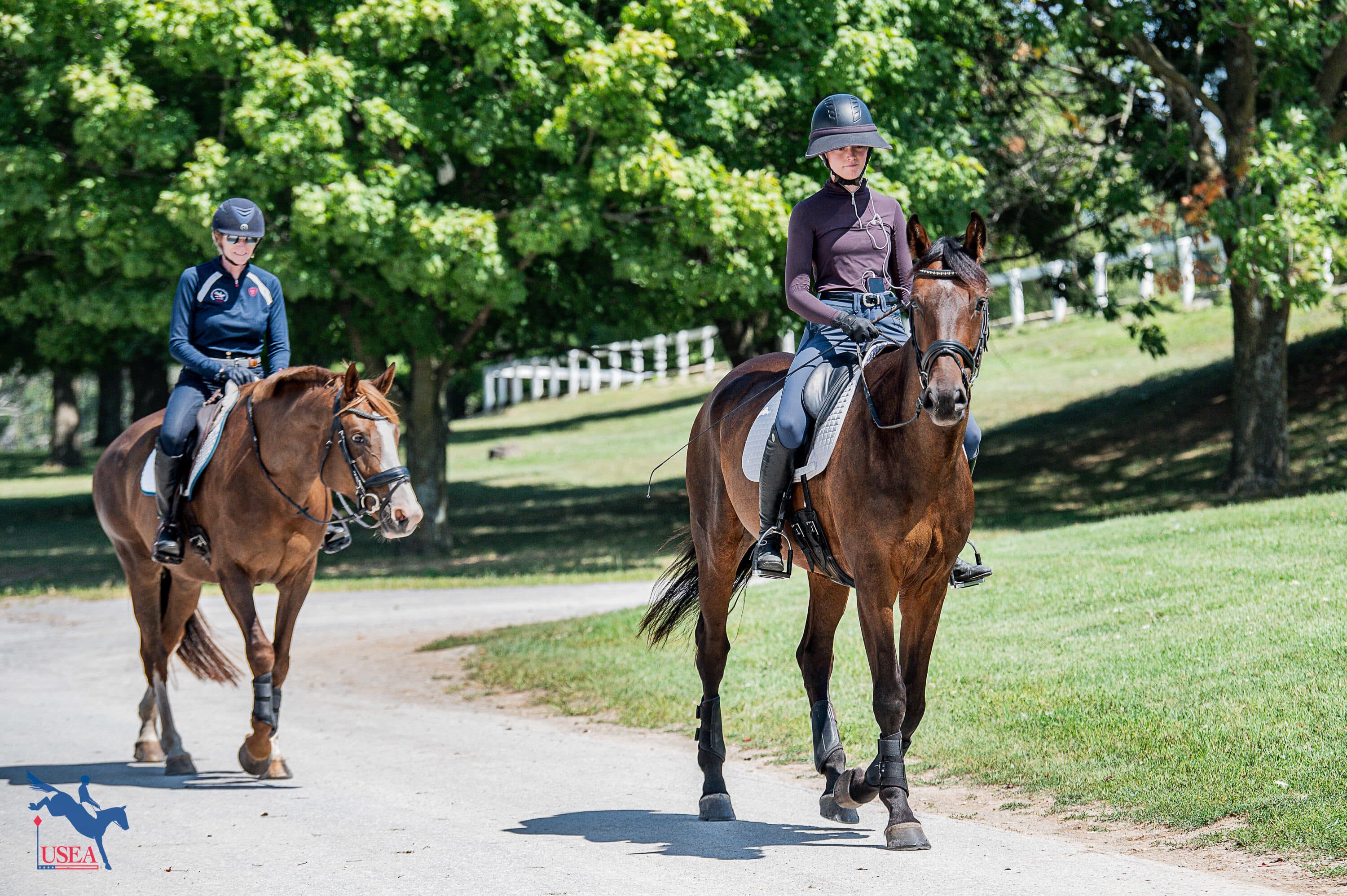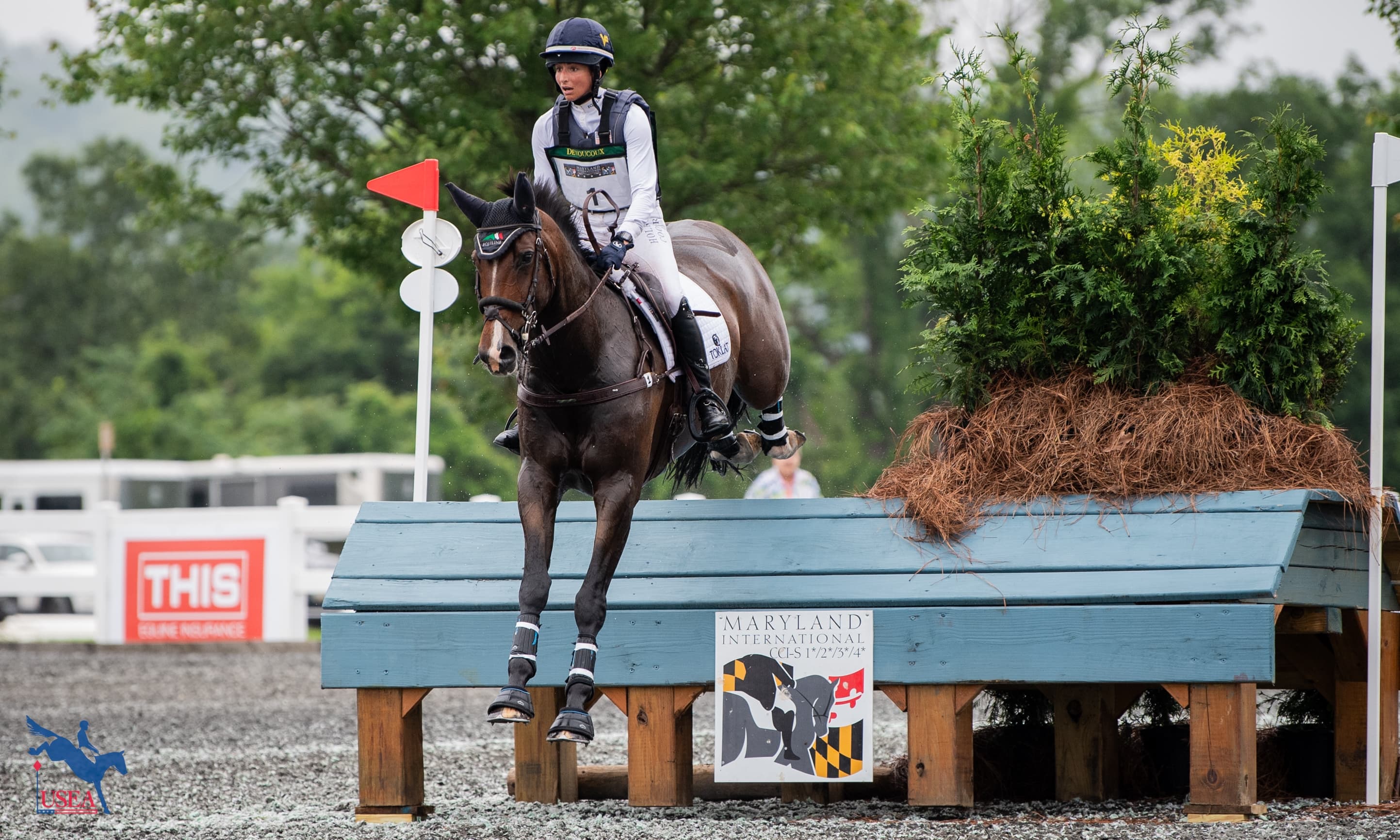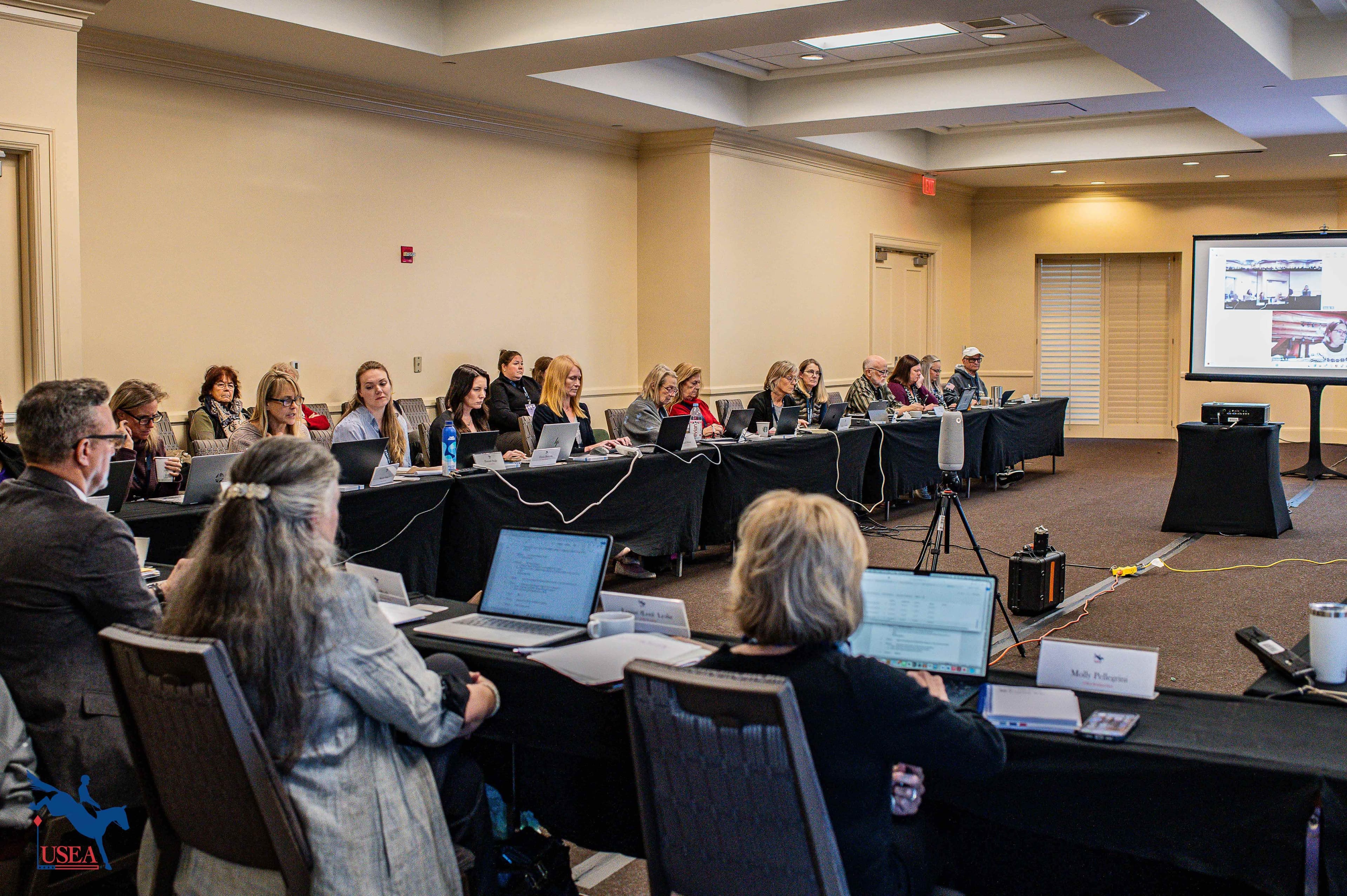The Benefits and Challenges of Instructing Group Rides

Group rides are an important tool to include in the education of both riders and horses to give them a well-rounded education, enhance the rider’s skills, and give confidence to both horses and riders. Managed well, group rides also add to the enjoyment of our sport.
Even though horses are herd animals, it is important, particularly with young and/or nervous horses, to expose them to group situations in a safe and controlled manner. Many horses are terrified when another horse is coming directly toward them at any pace, particularly if that horse is excited, misbehaving, shying, or being ridden by a rider who is not paying attention. Riders must always be aware of what is going on around them and be mindful of their own and others’ safety as well as being courteous to others.
Warm up rings can be chaotic and fraught with anxious horses and riders particularly at the lower or less experienced levels. It is the responsibility of riders, coaches, trainers, supporters, and parents to be mindful in these situations. There is no place for aggression, bullying, or bad manners in a warm up ring. Please always be considerate.
Here are some of the benefits and challenges of group rides.
Benefits of Group Rides
Group rides teach riders to safely manage their horses in all gaits and situations. Riders get the opportunity to become comfortable riding in groups and riding independently either in an enclosed area or out in the open while cross-country schooling, field hunting, and trail riding. They will need this skill to be safe and effective when warming up their horses in a crowded ring prior to competing. This can be a nerve-wracking experience. Riding in groups also familiarizes and desensitizes horses in warm up situations at shows.
Group rides teach riders to think for themselves. When the instructor’s attention is divided among the group, riders have an opportunity to think independently and take ownership over their decisions.
Group rides are easier on the horses compared to the intensity of private lessons. Though riders may learn more in a private lesson, they get more breaks in a group ride. Riders will learn different things in group lessons: riders can learn by watching each other, especially when new movements and exercises are introduced. They are able to watch how others practice an exercise and how they deal with challenges.
Group rides are fun! Group activities like riding in formation or pairs, and musical rides that incorporate many patterns are all fun, inclusive, and confidence-building.
Challenges with Group Rides
Horses and riders do not always cope well in group situations. Instructors must manage group rides well, otherwise situations can get out of control very quickly. Some challenges include:
Environmental challenges. Trail riding and cross-country schooling are conducted in the open and can be challenging to manage. Weather conditions must be taken into account: a group ride outside on a cold, windy day can turn into a disaster with riders out of control or getting bucked off! Learning is almost impossible in these situations, and it becomes a matter of survival for all.
Group rides are best conducted in an enclosed indoor or outdoor arena. There should be no hazards lying around. As a matter of safety and good manners, there needs to be a protocol for entering and leaving the arena. Many accidents occur when someone opens a gate or door and startles a horse who happens to be passing at that moment. Always look first, then clearly announce “coming in” or “going out.”
Too many riders in a group. Three to six riders can be a good number depending on their level of experience and competence. This would be fairly standard in a clinic. This number can increase in certain circumstances, for example, if you are a riding school proprietor and offer regular lessons and camps on school horses that are safe and familiar with each other.
Compatible experience levels between horses and riders. This is extremely important for safety and for the riders to get as much benefit as possible from the instruction. There needs to be a balance between challenging the riders and causing a panic response. The lesson needs to be taught to the lowest common denominator so as not to overwhelm the less experienced rider. This can cause frustration and even fear. The more experienced riders in the group will feel like they are getting nothing out of the lesson; the less experienced can be nervous and feel they are inadequate or are holding up the others. A competent and experienced instructor can manage some difference in the experience levels of horses and riders while managing safety, exercise demands, horse/rider fitness, and still keep the riders engaged, focused, and learning.
Group jumping lessons present unique challenges. The coach/instructor must be highly familiar and competent in their knowledge of correct distances for all the chosen exercises, as well as for horses versus ponies. One must understand all the variations when dealing with different stride lengths, temperaments, and ages of the horses, and choose exercises accordingly. These can include trotting poles, placing poles, gymnastics with bounces and strides, type of fences used, and related distances. A knowledge of the rules for each level is required so as not to overface riders and horses. A basic knowledge of correct course design is essential.
A prudent choice of jumping exercises is needed when dealing with horses and ponies in the same group. This is particularly relevant when using pole work and gymnastics as the distances need to be correct for each horse. Do not choose an exercise in these situations that could compromise the safety or confidence of a horse or rider. Choose an exercise or course plan that will work for all these scenarios with minimal moving of jumps and distances.
Group cross-country lessons present unique challenges. It is not a good idea to take riders out cross- country that the instructor has not seen riding and jumping prior to going out. The fundamentals must be assessed and established. The dressage/showjumping session gives essential information to the coach/instructor about the levels, experience, and capabilities of the riders and horses. It provides the opportunity to evaluate, make corrections, and ensure a measure of improvement in position, security, and the horses’ rideability prior to riding cross-country.
Cross-country schooling must be a positive experience for the horses and riders. Schooling sessions involve a lot of stopping and starting. This can be difficult for the horses as the adrenaline present when jumping a full course at an event is not the same. It is difficult to keep a consistent rhythm, impulsion, and balance when stopping and starting. An excitable, nervous horse does not do well in these situations and needs thoughtful management. For these reasons, it is better to school cross-country below the level of the competition. New questions and bigger fences can be introduced in a progressive way that will not pose a safety issue for horses and riders that will result in stops, falls, and loss of confidence which can be difficult, if not impossible, to correct. It is not always appropriate or necessary for everyone in the group to jump the same fences and heights. Every horse and rider must be treated as an individual within the group. It is helpful to explain to ambitious riders why it is not a good idea in a certain instance to jump a particular fence or combination.
More on Instructing Group Rides
It is important that the horses’ age, abilities, and fitness levels are taken into account when conducting the ride. The exercises chosen will depend on the experience, competence, and levels of the horses and riders. The instructor must be capable of controlling all the horses and riders in a group situation and have a toolbox of fun, level appropriate as well as educational group exercises to choose from. Group lessons are normally an hour long but can be up to two hours if it is part of a clinic. It will be much easier if it is a riding group where the horses all belong to the center and are well-known to the instructor. It could be a group that rides together regularly on their own horses.
A clinic presents more difficult challenges. The clinician generally does not know the horses and riders unless in repeat situations. It is important to get as much information on the participants as possible ahead of time. The organizer needs to be aware of each horse and rider’s experience and goals in order to keep the group level appropriate. The clinician needs to get as much information as possible from the riders at the beginning of the session as well as conducting a safety check of horse and rider equipment. This is not only a safety issue, but it gives the clinician some insight into the horse and rider’s experience, their training issues, their temperament, and their goals and provides the opportunity to structure and manage the lessons to achieve the best possible outcome for the participants.
A safety check of the horse and rider equipment must be done by the instructor prior to starting the lesson. All riders need to line up at the beginning and end of the lessons. Entering and exiting the arena and mounting, dismounting, must be in an organized, safe, and controlled manner. They must be taught to lead correctly, with stirrups up and reins held correctly. Choose a well-mannered horse or pony to be the leader. Be sure that they keep their distances (at least one horse’s length between them).
If the horses are different sizes, it helps if the bigger-striding ones are at the front. It can be challenging in group rides to give everyone equal attention. Try not to have the same person leading or starting off every exercise.
A group lesson of riders at the beginner or starter levels calls for simple exercises. They will not have a secure and independent seat yet. It is better to manage the ride as they will not be fully capable of riding or controlling their horses or riding independently. This is a skill that they will learn as they progress. It is not safe to have all of them cantering together.
Most riders get instruction in private lessons. Riders who have ridden in Pony Club or who learned to ride in a riding school or equestrian center generally get many more opportunities to ride in a group setting. If you have the opportunity to ride with a group, it can be a fun, educational, and rewarding experience. It also prepares you for the warm up arena at shows, riding in clinics, and gives you more confidence when invited on that trail ride or to go on a hunter pace or field hunting. Most instructors do not have the opportunity to teach group lessons unless they are involved in Pony Club, an equestrian center that offers group instruction, or if they conduct clinics or trail rides. Leading group rides can be especially challenging when the coach has never seen the horses and riders before. This is an important tool in the coach’s education, and it requires practice to become competent teaching and controlling groups in a safe and constructive manner.
About the USEA Eventing Coaches Program (ECP)
Coaches are essential to the training of riders and horses for safe and educated participation in the sport of eventing. The USEA Eventing Coaches Program (ECP), formerly known as the Instructors’ Certification Program (ICP), was initiated in 2002 to educate all levels of eventing coaches with crucial training principles upon which they can continue to build throughout their teaching careers. ECP offers educational workshops and assessments by which both regular coaches, Level I through Level V, Young Event Horse (YEH) coaches, and Young Event Horse professional horse trainers can become ECP certified. Additional information about ECP’s goals, benefits, workshops, and assessments as well as names and contact information for current ECP certified coaches, YEH coaches, and YEH professional horse trainers are available on the USEA website. Click here to learn more about the USEA Eventing Coaches Program.
The USEA would like to thank Parker Equine Insurance, the United States Pony Clubs, and Strider for their support of the Eventing Coaches Program.














